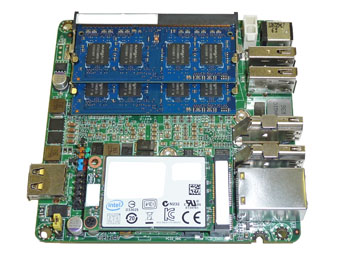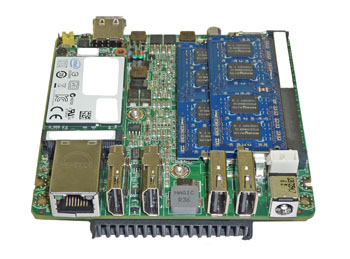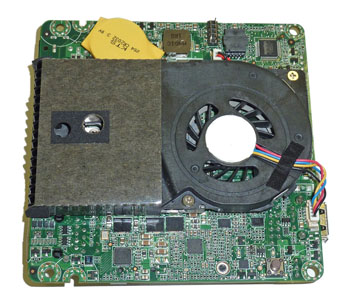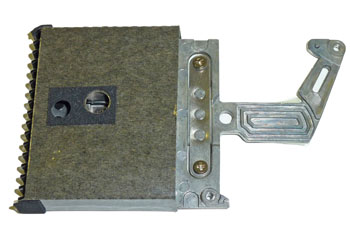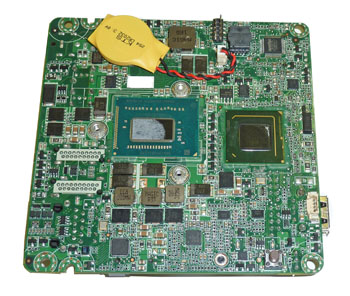A bit of NUCie
While we were over at Intel's Developer Forum (IDF) earlier this month in sunny San Francisco, the chip giant took time out to brief journalists on a supposedly new take on the traditional PC. Emboldened enough to call this new device the 'Next Unit of Computing' (NUC), initial thoughts were mixed, with £300-plus pricing being of primary concern. Intel is to debut NUC in two flavours starting out in October, but we've managed to snag a pre-production sample and given it a good going over.
Intel acutely understands that desktop PCs need to be made more appealing if they're to be extricated from the malaise affecting the industry, underscored by the chip giant cutting around $1bn from expected revenue in Q3 2012. And what better way of reinvigorating the flagging consumer business, albeit in a very, very small way, than by launching a whole new PC form factor?
The Intel-built NUC is based around a PCB that measures 10cm square. The board houses the various ports, memory, and expansion slots on one side and mobile CPU and chipset on the other. Looking at the top side first, as shown above, NUC incorporates two standard-sized SO-DIMM slots on the far side and a mini-PCIe located directly underneath an mSATA slot on the near side, and these four represent the sum of NUC's expandability.
But there's little reason to need more for a form factor of this size, frankly, as the system can easily be filled with 8GB of dual-channel RAM, a WiFi/Bluetooth combination card and a reasonable-capacity mSATA SSD. Our case-less sample, as it happens, came pre-equipped with 4GB of Nanya RAM, an 80GB Intel G2 SSD, and a multi-standard (unconnected) wireless adapter.
Shifting perspective leads your eye nicely to the ports' arrangement. Intel has plans to introduce NUCs with varying components and outputs. The base specification, demonstrated here, includes a Gigabit Ethernet port, two HDMI for dual-screen viewing, three USB 2.0, and an inlet for an external power brick. A second iteration of NUC is to include Thunderbolt connectivity in lieu of the anachronistic Ethernet, according to Intel.
Here's something we didn't see during our brief play with the NUC at IDF. Intel mentioned that, while NUC used established Mobile Core technology, active cooling would still be required to keep thermals in check, leading to a 50mm server-class blower fan to be installed over the CPU and associated chipset. A small heatsink makes contact with the underlying silicon, and its protruding profile ensures that a bare NUC sits unsteady on a desk.
Removing all cooling encumbrances shows the Mobile Core chip and Platform Controller Hub (PCH) dominate the centre of the board. Intel asserts that, in due course, NUCs will be outfitted with all manner of silicon, ranging from low-power Atoms to high-performance Mobile Core i7s. That said, this sample ships with a 3rd Generation (Ivy Bridge) Core i3-3217U dual-core, quad-thread chip, chiming in at 1.8GHz, outfitted with Intel HD 4000 Graphics and chewing through no more than 17W at full tilt. Other than a little extra cost, there's no reason why a Core i5-3427U can't be used, adding a little extra spice on the CPU front. The chips' BGA1023 package is common on many laptops, too, highlighting the NUC's provenance.
Intel's next-generation architecture, Haswell, will do away with the PCH altogether, bringing compute and connectivity on to one chip. Ivy Bridge keeps said PCH present, and this one is based on the QS77 chipset. Indeed, another look at the components makes it clear that Intel has taken the guts of a reasonable laptop and reimagined them into a dual-sided PCB called the NUC.
Flick back over and it takes but a second to remove the memory and mSATA SSD. It's unclear as to why the QS77's built-in USB 3.0 hasn't been transferred over to this model, though Intel may argue this NUC is geared towards the embedded market.
Intel is championing a smaller form factor but it's not close to the first time that such a move has been undertaken. VIA has lead the way for years with ultra-small form factors such as Pico and Nano-ITX, while ZOTAC has carved a niche with its barely-larger-than-NUC Nano boxes. Intel's use of its own laptop technology and decision to implement industry-standard expansion slots works well enough, we suppose, but the real test is in how consumers take to the mooted £500 price tag for a complete system, including case, SSD, WiFi and memory.
There's plenty to like here and Intel's first foray into ultra-small desktop computing makes sense from a component integration point of view. Question is, how well does it fare against established desktops? Read on to find out.






